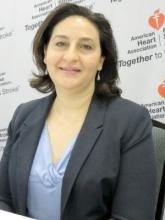NASHVILLE, TENN. – Patients who were clinically dehydrated when they presented with ischemic stroke were four times more likely to worsen over the next few days than were adequately hydrated patients in a single-center, retrospective study.
Hydration status didn’t appear to affect stroke infarct volume or severity, Dr. Mona Bahouth reported in a press briefing at the International Stroke Conference. Nevertheless, 42% of those considered dehydrated experienced no improvement or worsened during their stay, compared with 17% of the well-hydrated patients, said Dr. Bahouth, a neurology fellow at Johns Hopkins University, Baltimore.
It’s unclear how many stroke patients receive hydration therapy upon admission, she said. It’s also unclear how to provide it, since there are concerns about fluid overload from intravenous administration and swallowing and choking from oral intake. But if attention to hydration could help improve outcomes, “it would be one of the easiest things in the world to do,” Dr. Bahouth said at the meeting, which was sponsored by the American Heart Association.
The literature suggests a link between fluid status and stroke. Increased hemoglobin during acute stroke seems related to clinical deterioration after stroke, as does an elevated blood urea nitrogen (BUN)/creatinine ratio and serum osmolality. Dehydration means lower fluid volume in blood, which contributes to the prothrombotic state and puts shear stress on vessels, Dr. Bahouth said.
She retrospectively analyzed the records of 126 patients who presented with symptoms of acute stroke, with onset less than 12 hours from their last known normal function. In 44%, the BUN/creatinine ratio was more than 15 and urine specific gravity was greater than 1.010, indicating dehydration. All patients underwent MRI to determine infarct and perfusion volume.
The primary outcome was fluctuation in the National Institutes of Health Stroke Scale (NIHSS), and the quantitative change in NIHSS over 4 days post stroke.
Patients were a mean of 65 years old. About 15% had atrial fibrillation and a third had diabetes. The NIHSS on presentation was 7. Thrombolytic therapy had been administered in 40% of those with dehydration and 60% of those without it.
There were no between-group differences in stroke type, with 55% being a large anterior infarct, 10% a large posterior infarct, and the rest small-vessel lesions. Infarct volume was 12 mL in the group with dehydration and 16 mL in those without, which was not a significant difference. There also were no significant differences according to hydration status in terms of hypoperfusion, baseline NIHSS, infarct volume, or perfusion-weighted imaging/diffusion-weighted imaging mismatch ratio.
By day 4, NIHSS had improved in 83% of those without dehydration but in only 58% of those with dehydration. NIHSS was unchanged or had worsened in 17% of those without dehydration and 42% of those with. Both differences were statistically significant.
A multivariate regression analysis found no significant associations of declining clinical status with age, gender, infarct volume, or baseline glucose level, but dehydration upon admission conferred a fourfold risk for NIHSS deterioration.
Even though dehydration appears to be associated with clinical deterioration, the best way to handle it is unclear, according to Dr. Robert Adams, who moderated the session. Little research has been conducted on the issue in recent years; studies undertaken in the 1980s showed that blood viscosity was an important factor, but treating it with fluids didn’t seem to improve outcomes.
“There were clearly complications of pulmonary embolism in some patients, showing that it’s possible to go too far with fluids. The discussion now is, how much fluid would be beneficial,” said Dr. Adams, professor of neurology at the Medical University of South Carolina, Charleston, and director of South Carolina’s REACH Stroke Network.
Neither Dr. Bahouth nor Dr. Adams had any financial disclosures.
On Twitter @alz_gal


